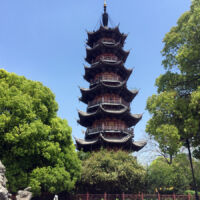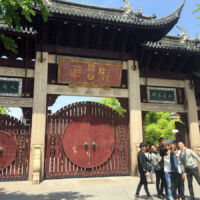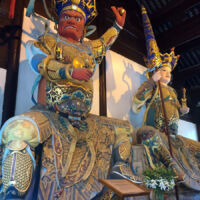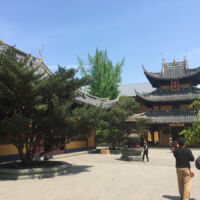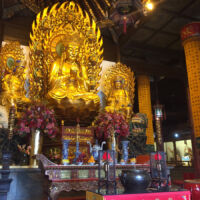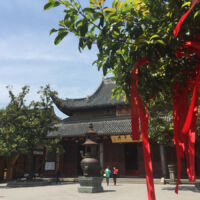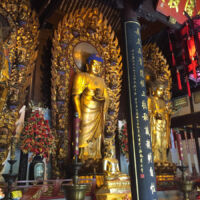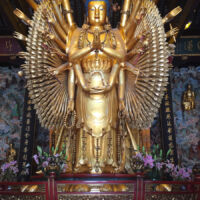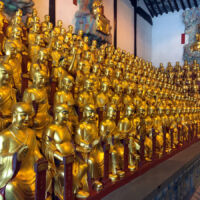Longhua Temple
Longhua Temple 龙华寺 and Pagoda was first built around 242 A.D. and is the oldest temple complex in Shanghai. Legend has it that Sun Quan, King of the Kingdom of Wu, got hold of some of the cremated remains of the Buddha. He had 13 pagodas built to house the relics, and Longhua Pagoda is one of them. Although the original buildings were destroyed by war and time, the present-day construction preserves the architectural design of the Song Dynasty. Most of the buildings were reconstructed during the Qing Dynasty and major restoration was carried out in 1954.
Longhua Martyrs Cemetery is behind the temple, appearing quite large on the map and seemingly overshadows the temple area. In early part of the 19th century, the temple site hosted public executions of suspected communists. In 1927 the Kuomintang (Chinese Nationalist Party) rounded up thousands of suspected communists in Shanghai and brought them to the temple grounds for execution. Today the Longhua Martyrs Cemetery serves as a burial grounds and memorial to those murdered during the purge.
Getting There
Address: 2853 Longhua Rd,
Xuhui, Shanghai, China
The easy way is by metro line number 11 or 12 to Longhua station. Line 12 is fairly new and may not be shown on Google maps. However, both lines get you there and are a short walk to the temple area.
- Google Map
- Shanghai Metro Map
- Use Smart Shanghai iPhone app for taxi-friendly address
Fees
Entry fee is ¥10 for the temple area.
Your entry ticket includes a small packet of incense to burn. Find the incense at the entry gate and light them in the courtyard. You cannot walk around with a burning incense of course, so be sure to put it in the designated bin to burn down. You can also buy more inside if you want.
You may also want to consider donating money at various points while inside the temple. I suggest bringing a hand full of change and enjoy placing small amounts into the donation boxes at each of the halls. A couple of large urns between halls prompt people to jump up and toss coins inside. Give it a try if you so desire.
What To See and Do
The Longhua Pagoda is ~40 meters high and is just outside the temple walls.
The layout of the temple reflects a Song dynasty monastery of the Buddhist Chan sect, known as the Sangharama Five-Hall Style. Five main halls are arranged along a central north-south pointing axis. From the entrance:
The Maitreya Hall has a statue of Maitreya Buddha and another in his manifestation as “Budai,” or Cloth bag monk.
The Heavenly King Hall houses large statues of the Four Heavenly Kings.
The Grand Hall of the Great Sage is the main hall which keeps the three treasures of the temple. This hall has statues of the historical Buddha and two disciples. The twenty Guardians of Buddhist Law are arranged around the perimeter, and around the back you will find the sixteen principal arhats.
The Three Sages Hall houses statues of the Amitabha Buddha, Buddistavas Avalokiteśvara and Mahāsthāmaprāpta.
The Abbot’s Hall is a place for lectures and formal meetings.
Buildings flanking the large central halls house shops and more artwork such as statues of the 500 arhats.
